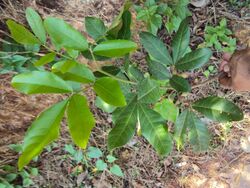Biology:Aglaia elaeagnoidea
| Aglaia elaeagnoidea | |
|---|---|

| |
| Scientific classification | |
| Kingdom: | Plantae |
| Clade: | Tracheophytes |
| Clade: | Angiosperms |
| Clade: | Eudicots |
| Clade: | Rosids |
| Order: | Sapindales |
| Family: | Meliaceae |
| Genus: | Aglaia |
| Species: | A. elaeagnoidea
|
| Binomial name | |
| Aglaia elaeagnoidea (A.Juss.) Benth.
| |
| Synonyms | |
| |
Aglaia elaeagnoidea, the droopy leaf or priyangu,[3] is a species of plant in the family Meliaceae. It is a 10m tall tree found in American Samoa, Australia (Western Australia and Queensland), Cambodia, China , India , Indonesia, Malaysia, New Caledonia, Papua New Guinea, the Philippines , Samoa, Sri Lanka, Taiwan (Hengchun Peninsula (zh)[4][5]), Thailand, Vanuatu, and Vietnam.[6]
Description
Timber is bright red color is a hard wood.[7] Bark is greyish brown in color. White latex can be exudate. Leaves are compound, imparipinnate, alternate; lamina narrow-elliptic to oblanceolate; apex bluntly acute to subacuminate; base acute to cuneate.[8] Flowers show axillary panicles inflorescence. Fruit is a brown or red, indehiscent[9] globose berry.[10]
Common names
- English — droopy leaf, priyangu, coastal boodyarra
- Hindi — Script error: The function "transl" does not exist. (प्रियंगू)
- Tamil — Script error: The function "transl" does not exist., Script error: The function "transl" does not exist.
- Malayalam — Script error: The function "transl" does not exist., Script error: The function "transl" does not exist., Script error: The function "transl" does not exist.
- Telugu — Script error: The function "transl" does not exist., Script error: The function "transl" does not exist., Script error: The function "transl" does not exist.
- Kannada — Script error: The function "transl" does not exist., Script error: The function "transl" does not exist., Script error: The function "transl" does not exist., Script error: The function "transl" does not exist.
- Mandarin — Script error: The function "transl" does not exist., Script error: The function "transl" does not exist. (red wood)
- Sinhala — Script error: The function "transl" does not exist.[11]
Uses
The wood is hard and is a good material for construction. The aborigines often used it to build houses in Taiwan. It can also be used to make various utensils.[12])
References
- ↑ Pannell, C.M. (1998). "Aglaia elaeagnoidea". IUCN Red List of Threatened Species 1998: e.T33711A9804005. doi:10.2305/IUCN.UK.1998.RLTS.T33711A9804005.en. https://www.iucnredlist.org/species/33711/9804005. Retrieved 16 November 2021.
- ↑ "Aglaia elaeagnoidea (A.Juss.) Benth. — the Plant List". http://www.theplantlist.org/tpl/record/kew-2626281.
- ↑ "Aglaia elaeagnoidea - Priyangu". http://www.flowersofindia.net/catalog/slides/Priyangu.html.
- ↑ "Aglaia elaeagnoidea (A. Jussieu) Bentham, Fl. Austral. 1: 383. 1863." (in en). www.efloras.org. http://www.efloras.org/florataxon.aspx?flora_id=2&taxon_id=242301566. Retrieved 2022-12-15.
- ↑ "Aglaia formosana 紅柴 Aglaia formosana Hayata" (in en). 國立台灣大學生態學與演化生物學研究所. https://tai2.ntu.edu.tw/species/420%20001%2003%200. Retrieved 2022-12-15.
- ↑ "Aglaia elaeagnoidea (A. Juss.) Benth". http://indiabiodiversity.org/species/show/7168.
- ↑ "Aglaia elaeagnoidea". http://www.somemagneticislandplants.com.au/index.php/plants/591-aglaia-elaeagnoidea.
- ↑ "Aglaia elaeagnoidea". Commonwealth Scientific and Industrial Research Organisation (CSIRO). https://apps.lucidcentral.org/rainforest/text/entities/aglaia_elaeagnoidea.htm.
- ↑ "Aglaia elaeagnoidea". http://www.asianplant.net/Meliaceae/Aglaia_elaeagnoidea.htm.
- ↑ "Aglaia elaeagnoidea - MELIACEAE". http://www.biotik.org/india/species/a/aglaelae/aglaelae_en.html.
- ↑ http://www.greenlankavacations.com/en/index.php/day-tours/itemlist/tag/Bird%20Sanctuaries
- ↑ "紅材" (in zh). Hengchun Tropical Botanic Garden. https://hctbg.tfri.gov.tw/plants.php?func=detail&id=0000494. Retrieved 2022-12-15.
- "Aglaia elaeagnoidea (A.Juss.) Benth.". Atlas of Living Australia. https://bie.ala.org.au/species/http://id.biodiversity.org.au/node/apni/2887905.
Wikidata ☰ Q1245362 entry
 |


